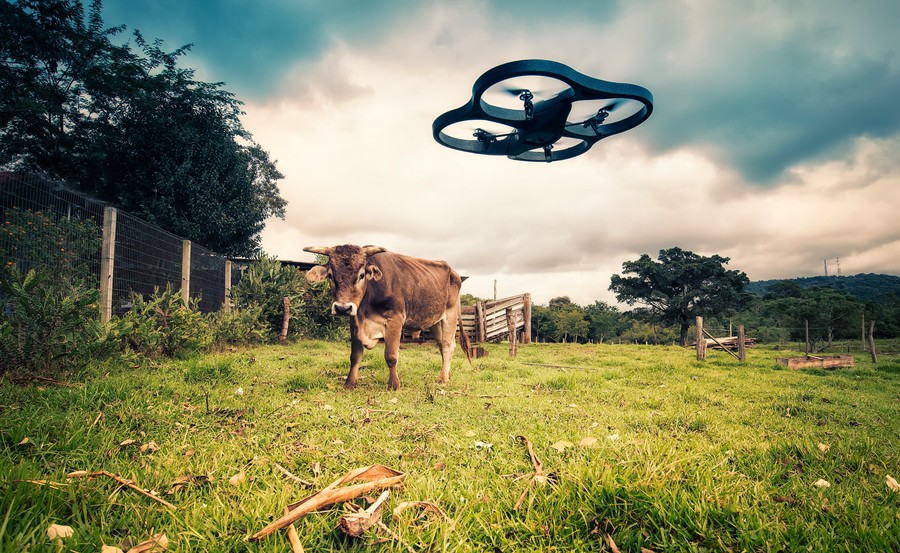
10 October, 2024

Peter Mooney
Posted: 20 October, 2017

Dr Peter Mooney is a lecturer in the Department of Computer Science at Maynooth University. His research interests include information and communication technologies for environmental sustainability and protection. He joins us today to talk about the ‘smart farming’ revolution and how technology will change farmers’ lives.
Picture the scene. A drone flies, by itself, on a pre-defined route around your farm and fields checking on livestock, monitoring the growth of crops, and gathering data. Intelligent sensors placed in livestock sheds monitor sounds and movements for any potential sign of animal illness which will subsequently alert you by text message or email. Sensors on livestock track movement and health and allow seamless 24-7 monitoring regardless of where the animals are or what they are doing. Self-driving machinery are taking soil or crop samples in order to determine if it is the correct time to plant new crops or harvest existing ones. Smart CCTV camera systems monitor for potential hazards or safety issues around the farm such as open doors, children accessing sheds or trip hazards. Environmental sensors connected in a network around the farm can make continuous observations of air quality, rainfall and sunshine.
From anywhere on the farm, the milking parlour, the field, the kitchen or the jeep, the farmer has full control over these machines from their smartphones or tablets. At their fingertips is a treasure trove of new data, information and knowledge about their farm. All of these systems and sensors working together to help the farmer make more efficient, effective, sustainable and intelligent decisions with the most up-to-date data and information. This picture of a futuristic farm is what we call ‘smart farming’. ‘Smart farming’ represents the application of modern information and communication technologies (ICT) into agriculture, leading to what has been called a ‘fourth agricultural revolution’. The ICT we are so familiar with today; smart devices, wearable sensors, location-based services and automated systems are all components in this ‘smart farming’ revolution. It might appear that this picture is more science fiction than reality. This could not be further from the truth. Most of the technologies, systems, services and sensors described above are already, in some cases, operational or at least in a very advanced stage of prototype development.
Should farmers in Ireland be worried about this ‘agricultural revolution’? Absolutely not. ‘Smart farming’ is not a substitute or a replacement for the farmer and his team. ‘Smart farming’ should never been seen as a replacement for an experienced farm stock handler, however it can provide information and knowledge into the hands of farmers allowing them to make more effective, efficient and timely decisions. While intelligent agricultural machinery and systems can be used to manage standard farming situations, the farmer still needs to keep an eye out for unforeseen events or situations. In particular, the next generation of farmers will see this picture of ‘smart farming’ as completely normal and acceptable. The farmers who are growing up today have been born into a world immersed in technology. For these farmers, the integration of smart technologies into their everyday lives on the farm will be a natural choice.
Such profound changes in agricultural practice come not only with immense opportunities but also big challenges. To prevent the latest technology and knowledge being restricted to large and industrialised farms, it is crucial that more accessible training and educational opportunities are provided in ICT for farmers and those involved in agricultural management. This begins in primary school and leads right up to those involved in ‘smart farming’ as their livelihood. The opportunities include accessing courses on working with smart technologies, training in specialised areas, and becoming more familiar with how all of these technologies work. The smart farmer will be IT savvy and not afraid to embrace new technologies.
When the first phase of rural electrification happened in 1947, it transformed the lives of hundreds of thousands of people, it made farming and household tasks less challenging and greatly contributed to reducing social isolation. The provision of high quality broadband and internet access to all parts of rural Ireland will be our generation’s version of rural electrification. Until these telecommunication infrastructures are provided, ‘smart farming’ will be restricted to the few rather than available to the many. Policy makers, planners and technologists should place this high on their agendas.
Disclaimer: The opinions expressed in our guest blogs are the author’s own, and do not reflect the opinions of the Irish Research Council or any employee thereof. Photo credit: David Lamb, University of New England.